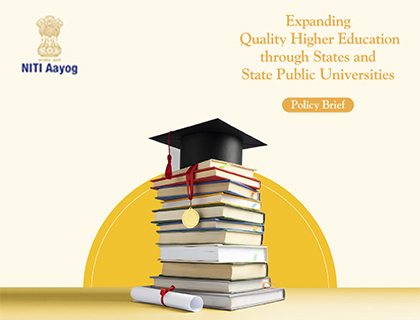Revitalizing State Universities: NITI Aayog’s Vision for Quality Higher Education

- 11 May 2025
In News:
India’s higher education sector, the third largest in the world, is largely shaped by its state universities. In its recent report titled ‘Expanding Quality Higher Education through States and State Universities’, NITI Aayog critically analyses the systemic challenges in these institutions and offers a strategic roadmap to enhance their quality, inclusivity, and global competitiveness.
Role of State Universities in India’s Higher Education Ecosystem
State universities constitute nearly 80% of all higher education institutions in India and cater to the majority of enrolled students. They play a pivotal role in ensuring access to education across socio-economic and geographical divides, particularly in underserved regions. Their contribution is crucial to India’s goals of inclusive development, knowledge-driven growth, and human capital formation. Consequently, their performance directly influences India’s research output, innovation capacity, and global academic standing.
Challenges Highlighted in the Report
1. Inadequate Investment and Uneven Funding Patterns: The report underscores the lack of consistent public investment in higher education. While some states like Kerala and Tamil Nadu invest substantially, others like Karnataka, despite high college density and enrolment, spend comparatively less. This disparity leads to uneven development and limits potential in several regions.
2. Declining Financial Commitment from States: There is a noticeable decline in state-level financial support for higher education, compounded by limited capacity to implement recommended reforms. The report calls for greater central assistance to bridge fiscal gaps and ensure a uniform quality of education nationwide.
3. Quality Deficit and Research Gaps: State universities often lack robust infrastructure, qualified faculty, and research funding. As a result, India’s institutions fall short in global rankings, reflecting systemic weaknesses. There exists a pressing need to strengthen research ecosystems and align academic output with innovation.
4. Governance and Autonomy Issues: Excessive political interference and bureaucratic hurdles dilute institutional autonomy. The report flags the tension between central regulatory bodies and state institutions, urging reforms that empower universities with greater academic and administrative freedom.
Key Recommendations
- Strengthening Research and Innovation: The creation of Centres of Excellence, dedicated research universities, and collaboration with global institutions are essential. Funding mechanisms should prioritise research aligned with national goals.
- Pedagogical Reforms and Multidisciplinary Learning: Promotion of interdisciplinary education, digital tools, and experiential learning is advocated. Regular faculty training and industry collaboration are needed to ensure skill-oriented learning.
- Financial Reforms and Public-Private Partnerships: States should aim to increase GDP spending on higher education. The report recommends performance-linked funding and encourages PPP models for infrastructure and capacity building.
- Performance Monitoring: Over 120 performance indicators have been proposed to evaluate outcomes. A system of short-, medium-, and long-term targets will guide progress through regular institutional reviews.
- Governance Reforms: Autonomy is key to excellence. Decentralised decision-making, transparent accreditation, and robust ranking systems are essential for institutional accountability and quality assurance.
Implementation Challenges
The success of these reforms hinges on overcoming several hurdles. Financial constraints, political interference, and faculty shortages persist. Mobilising alternative funding sources like CSR, insulating academia from politics, and capacity building are crucial steps.
Conclusion
NITI Aayog’s blueprint provides a timely and necessary intervention to revitalise India’s state universities. These institutions, forming the bedrock of India’s higher education framework, must be empowered through coordinated action by both state and central governments. Only then can India realize its vision of inclusive, equitable, and globally competitive higher education.
